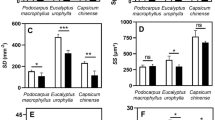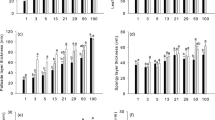Abstract
The appearance of stomatal patchiness in response to rapid (seconds) changes in light has been studied in European beech, Fagus sylvatica L., and, by comparison, in a further 17 different woody species from the understorey of a European beech forest, using a simple water infiltration method. Water infiltrated areoles indicate open stomata. Since infiltration changes optical characteristics of a leaf section it can be analysed by photography, computer-aided image analysis and by weighing. For F. sylvatica clear differences were found between infiltration of cotyledons (no patchy pattern) and any other leaf type. Despite identical cultivation, leaves of the same type and age from different individual plants responded differently to application of 30 s of light after darkness. In contrast, the patchiness patterns were very similar for leaves of the same type originating from the same plant. Infiltration patterns after a light-fleck, observed on different leaves as a series of momentary clusters, probably indicate waves of opening stomata moving across the leaf blade. During and after a 30 s light-fleck infiltration increased and it continued to increase in the dark up to 10 min, indicating increasing stomatal opening over that period. In general, shade leaves became more infiltrated (by weight) than half-shade or sun leaves, due to larger intercellular air spaces. All species, without exception, showed patchy infiltration and, thus, non-uniform stomatal opening. Measuring leaf gas exchange (as ”quasi-steady states” using a fast responding system) during photosynthetic induction resulted in very similar CO2 responses of net photosynthesis (A/c i) as in the true steady state, proving that, in shade and half-shade leaves, the presence of stomatal patchiness does not necessarily affect the calculation of intercellular CO2 concentrations. Causes and consequences of stomatal patchiness are discussed.
Similar content being viewed by others
Author information
Authors and Affiliations
Additional information
Received: 18 November 1998 / Accepted: 1 July 1999
Rights and permissions
About this article
Cite this article
Küppers, M., Heiland, I., Schneider, H. et al. Light-flecks cause non-uniform stomatal opening – studies with special emphasis on Fagus sylvatica L. . Trees 14, 130–144 (1999). https://doi.org/10.1007/PL00009759
Issue Date:
DOI: https://doi.org/10.1007/PL00009759




